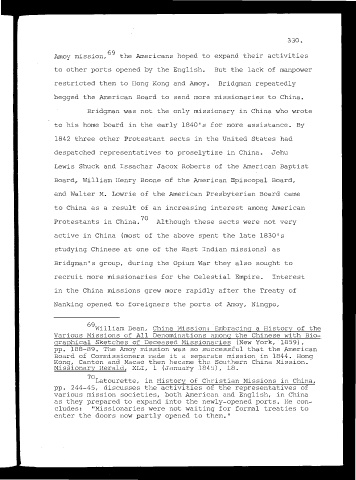Page 344 - Merchants and Mandarins China Trade Era
P. 344
330.
6 9 ·
e
h
Arnoy mission, th Arn ericans ope d t o expan d th . t . . t . ies
·
·
eir ac ivi
to other ports opened by the English. But the lack of manpower
restricted them to Hong Kong and Arnoy. Bridgman repeatedly
begged the American Board to send more missionaries to China.
Bridgman was not the only missionary in China who wrote
to his home board in the early 1840's for more assistance. By
1842 three other Protestant sects in the United States had
despatched representatives to proselytize in China. Jehu
Lewis Shuck and Issachar Jacox Roberts of the American Baptist
Boardu William Henry Boone of the American Episcopal Board,
and Walter M. Lowrie of the American Presbyterian Board came
to China as a result of an increasing interest among American
70
Protestants in China. Although these sects were not very
1
active in China (most of the above spent the late 1830 s
studying Chinese at one of the East Indian missions) as
Bridgman's group, during the Opium War they also sought to
recruit more missionaries for the Celestial Empire. Interest
in the China missions grew more rapidly after the Treaty of
Nanking opened to foreigners the ports of Arnoy, Ningpo,
69
william Dean, China Mission: Embracing a History of the
Various Missions of All Denominations among the Chinese with Bio
graphical Sketches of Deceased Missionaries (New York, 1859),
pp. 188-89. The Arnoy mission was so successful that the American
Board of Cormnissioners made it a separate mission in 1844. Hong
Kong, Canton and Macao then became the Southern China Mission.
Missionary Herald, XLI, 1 (January 1845), 18.
70
Latourette, in History of Christian Missions in China,
pp. 244-45, discusses the activities of the representatives of
various mission societies, both American and English, in China
as they prepared to expand into the newly-opened ports. He con
cludes: "Missionaries were not waiting for formal treaties to
enter the doors now partly opened to them."

